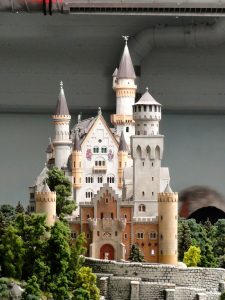Miniatur Wunderland, Hamburg
Hamburg’s Miniatur Wunderland is one of the city’s most visited attractions, with over 1.2 million visitors per year. When we were first in the city, our tight budget (of money and time) prevented us paying the €12 entrance fee and waiting for the next open time slot an hour away, but we finally got there on our most recent visit.
When looking into opening hours online, I was impressed by the waiting-time prediction graphics on the website. As the complex receives so many visitors, a limited number of people are allowed to enter at a time so that everyone has a chance to see the displays; your ticket is printed with your entrance time. If you book in advance or arrive at a slow time, you can go in immediately, but if you just show up you might have to wait for as long as two hours before your slot comes up.
When we arrived at 11am on a Wednesday, waiting time was around an hour and the six clerks on duty were all busy with customers. Inside, the place was packed with hundreds of people of all ages enjoying the displays, which spread across two floors.
We started on the lower floor, checking out the two small square diorama series: one shows an area of Germany in stages from pre-history to today, the other documents a street in Berlin from immediately after the Second World War until the fall of the Wall in 1989. Both series were well done, but I was disappointed that the explanatory brochures on nearby stands were only in German, as was the audio on the prehistory one. We’d been given English maps of the complex, but these didn’t help us understand the smaller dioramas.

Of course, a major factor of the Wunderland is the model railway. Hundreds of vehicles make their way through the crafted world, adding life and movement to the displays. And it’s not just trains, but also cars, trucks, boats, and other vehicles — even planes. At the Knuffingen Airport section you can see planes take off and land; a TV screen above shows how the technology works.
A control desk in the centre of the room is manned by several staff members, who keep track of where the vehicles are; downstairs you can also see some of the model makers hard at work. When we were there, the lower floor displays were being extended — the large Switzerland section was completed but Pompeii, Rome, Venice, and other areas of Italy were represented by paper plans and representative pictures only.
We spent about 90 minutes in the complex, and really enjoyed it — the workmanship and artistry was admirable. It’s particularly worthwhile if you’re interested in trains or models, but I think most visitors will find something to interest them. However, I recommend that you plan to visit as soon as the Wunderland opens in the morning, as even with the entrance controls, the complex is still crowded and it can be difficult to see some of the displays.
[box]Book a bed in Hamburg.[/box]